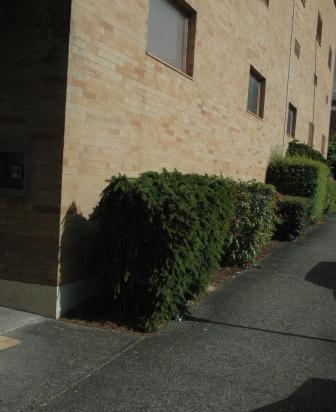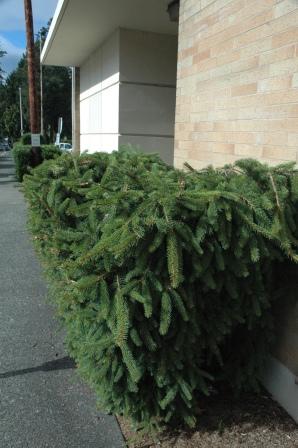One of the first courses a horticulture student takes is plant materials, or, in the case of a forestry student, dendrology. Why? Pretty simple; it’s hard to select plants if you don’t know what they are and what they’ll do in the landscape. Of course, the classic example is a large tree or shrub planted in a tight spot that eventually devours an entire house. But we usually don’t have to look too far to find situations where a homeowner or landscaper clearly had no idea what plant he or she was dealing with. To wit, a couple of recent examples of poor plant choices (maybe this can be our next series after “Why do nurseries still grow THAT?”)

I spotted the first example wandering through downtown in my hometown of Olympia, WA. At first glace it looks like an ordinary hedge; boxy to by sure, but nothing remarkable.

As I passed by though I noticed the hedge was actually a weeping Norway spruce (Picea abies ‘pendula’ – actually it could have been an ‘inversa’ – the repeated butchering made it hard to tell). Either way, what could have otherwise been a fairly interesting plant had been reduced to a squared-off blob of blech. The other side, of course, is that if a squared off blob of blech is truly desired there are cheaper and easier ways to achieve the effect.
The other example of the perils of not knowing your plant material comes from northern Michigan. This case represents that other extreme of trees that grow too large for their space. Here the homeowner wanted to screen his house (on the left but out of camera range to protect the guilty!) from the railroad track on the right of the photo. Solution: Plant some conifers! Sounds like a good idea to me.

Only problem – the owner chose to plant the screen with dwarf Alberta spruces! As with the blob of blech, the property owner could have achieved the desired screen in a couple of years and at a small fraction of the cost with seedlings from their local conservation district or seedling nursery. In any event, we’ll check back in about 40 years and see how it’s working out for them…
Bert, that last photo cracks me up! Great idea for another ongoing series.
I see problem plantings nearly every day, some planted by homeowners, but others by landscape professionals. Despite their academic credentials I see landscape architects and designers make the same mistakes continually. My neighbor has a row of Cedrus atlantica planted by a local landscaper (not my company) in a similar situation to the weeping Norway spruces in your photos. They’re unpruned, nearly twenty feet tall, and still growing. I suspect the culprits in this case had no design training at all, but I’ve found that, in general, plant knowledge by people with design degrees is quite poor. Too many lack the intellectual curiosity to continue their learning.
Oh, you have successfully found my soap box! One of the first things I did when I started to work as a groundskeeper was take out the giant sequoia and western red-cedar that were planted 4 feet from the building. I’ve now removed at least half of the plant material that
was put in by a landscaping company due to similar inappropriate plant choice. Why, oh WHY can’t they just take a plant materials class?!?!
After having taught Selection and Management of Landscape Plants for several years, I can tell you that the majority (but not all) of LA majors I taught have little regard for the three required classes in plant sciences. That being said, there was a minority of LA students, including the MLAs, who “got it.” These are the students that have gone on to be excellent landscape architects, blending science with design. Wish there were more of them.
Why would someone with little regard for plants want to become a landscape architect? It would be like a veterinarian who dislikes animals.
VG, there are many people who see plants as just another design element. (Just watch some of the shows on HGTV to get a good sense of that!) That’s why we get overplanted landscapes, poor plant choices, and other questionable practices that don’t take into account the interactions between plants and their environment.
At the risk of ‘piling on’ the LA’s and to echo Linda’s comments; for many their final product is the design or rendering- not the landscape itself.
Just today I was watching HGTV show where a landscape “renovation” was part of improving a property’s chance of selling. While experts were used for the carpentry and painting parts of the renovation, the designer used the homeowner’s children to stick $150 worth of plants into the ground. What a joke.
Let me join in the chorus, as a landscape architect who is frequently embarrassed and enraged at the bone-headed planting plans I see from my fellow L.A.s. Bert hit it on the head: year ago I worked for a landscape architect who’s primary focus seemed to be creating beautiful plans, regardless of the actual result that would come from them.
Linda: You’d enjoy my writings and photo galleries at FB and Flickr that I call “Crimes against horticulture” with some of the most egregious examples of wrong plant /wrong place and the work of “plant janitors” who are all about making cubes, phalluses and UFOs out of any plant they meet.
I’m gonna lie down now and compose myself.
Just like my mother’s words. She always told us to know more about the characteristics of plants in our garden. She has deep feelings for every plant and treats them as family member and I respect her thoughts.
You hire a plumber to fix your pipes, you hire an electrican to fix your wireing and you hire a high school kid to trim your shurbs.
“Billy Goodnick” I love your expression, “Plant janitors” too terribly true.
Billy, thanks for the link to your photo album! You would enjoy Plant Amensty’s page (“whose mission is to end the senseless torture and mutilation of trees and shrubs”). Their photo gallary is at http://www.plantamnesty.org/pruning_gallery/thumbs/bad_pruning_thumbs.htm.
I’m amazed at the writer’s myopic judgment of the weeping Norway spruce. I happen to think that the end result as a rectangular hedge is glorious, and could only have been achieved by careful pruning of this graceful spruce. Open your mind and broaden your horizons to alternative and unconventional viewpoints!
i wanted it for my projects bad